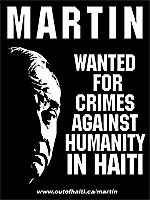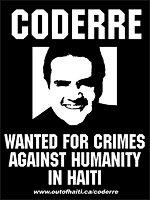
Cut and Paint

Cut&Paint is a zine of stencil templates, ready to cut, ready to paint.
Volume two is in the works with a deadline for submissions on February 20, 2006. In addition to stencils, the issue will include a how-to section, photos of stencils on site, and articles on stenciling, public space, and politics. Check the submission criteria.
The first issue is nearly sold out of its run of 400 copies, so I helped the team post the stencils online. It’s a quick and basic site for now, but will evolve as we add more images. The first 41 stencils are up and ready for download at http://cutandpaint.org.
Canada Out of Haiti!
Reader dru writes in about this graphic campaign around the upcoming elections in Canada:
“In February 2004, Canada backed a coup that removed Haiti’s democratically elected president (Aristide) and the entire elected government. Since then, they’ve been training police that have been shooting demonstrators, and propping up a ‘justice’ system that is systematically jailing political dissidents (the ones that aren’t in hiding or dead).
A bunch of Haiti solidarity activists are trying to unseat the Foreign Minister, Pierre Pettigrew (who had a brief cameo in The Corporation as a corrupt international trade minister), who played a key role (and continues to) in backing the post-coup government.
In the last election, he won by a very small margin in his riding of Papineau in north Montreal, which has a high population of Haitians.
In conjunction with groups in the Haitian community there, we're waging an all-out propaganda battle to unseat Pettigrew. Thousands of these posters: http://outofhaiti.ca/pettigrew/
Similar flyers have been distributed in the riding, and we hope to get a few thousand more out before election day (Jan. 23). Because the riding is such a hotspot, our posters have appeared on two nationally-broadcast TV news shows (in French and English).
Posters have also been created for the Prime Minister and his special advisor on Haiti and are going up in cities all across Canada.”
Read more about the campaign at http://outofhaiti.ca/
Where It’s At
On the west coast last month, I had a chance to visit the amazing folks of the Desgin Action Colletive in Oakland. Talking process and vision, something Innosanto Nagara said really stuck with me. It was something like:
“The challenge for progressives is not a lack of ideas. The models exist. The arguments exist.
But when you ask someone on the street if they want universal health care tomorrow, they say ‘Oh, that’s communism.’
The problem is a failure to communicate. And visual communications is a powerful tool that we need to learn to use better.
I strongly believe that on-the-ground organizing is where it’s at. And the communications work we do is to augment that.”
Now there’s a concise manifesto.
Guide to Recycled and Ecological Papers
 Via that same issue of Print I found this interesting matrix of recycled and tree-free papers assembled by Celery Design. About the guide:
Via that same issue of Print I found this interesting matrix of recycled and tree-free papers assembled by Celery Design. About the guide:
“Most graphics professionals are searching for a few simple things in a paper the highest quality, the easiest functionality, and the lowest price. The goal of this guide is to help you add one more critical consideration to the decision making process: the environmental impact of the paper you specify.
Through your paper choices, you are directly connected to the preservation or the degradation of land, water, air, and the creatures that dwell therein. Paper reps and printers provide guidance on finding the best quality, functionality and price, but often can’t help when it comes to preserving the environment. This guide fills that information gap and points you to the very best recycled and tree free papers on the market today. You will discover that most of these papers are also very competitive in terms of quality, functionality, and price.
The recycled and tree-free papers listed here generate fewer toxins and impact the environment far less than typical virgin wood, chlorine-bleached papers. There are options here in nearly every grade, format and price category. We encourage you to contact the paper manufacturers for samples, pricing, and ordering information, and work with your clients and printers to specify these papers. We developed this guide as an easy-to-use, practical tool that makes it simple to change old paper-buying habits. Use it and share it with your friends. With the right information and a bit of initiative, each of us can reach a higher standard for our graphics projects.”
It’s not clear when the guide was last updated, but do bookmark the page at http://www.celerydesign.com/paper/matrix.html
What’s missing from the list are more tree-free, “synthetic” alternatives to paper like:
- TerraSkin, a biodegradable paper made of mineral powder.
- Yupo, made of 100% polypropylene. Not biodegradable, but easy to reconstitute.
- NatureWorks PLA, a biodegradable corn-derived polymer, primarily used for packaging.
Anyone know of other good resources on alternatives to paper?
...
Update July 27, 2005:
More suppliers of tree-free and recycled papers are listed at Rainforest Web
Update August 28, 2005:
The San Francisco AIGA’s Ecological Guide to Paper lists 20 papers that are either 100% recycled, tree-free, or some combination of both
Update October 31, 2005:
Conservatree has lots of good information:
They also offer consulting services.
For more on changing your organization’s paper policy, see the Environmental Paper Network’s Environmentally Preferable Paper Purchasing Guidance (436 Kb PDF).
Fill in the Blank
From an interview with Dan Bar-On, co-founder of the Peace Research Institute in the Middle East:
“
One of our projects is to develop a new school textbook with a group of Palestinian teachers and Israeli teachers and two historians. We suggested that they take some dates from the history of the conflict... there were three dates: 1917, the Balfour Declaration, 1948, and the First Intifada. Each teacher should write his own narrative about these dates. Then they read each other’s narratives, they commented on them, and they asked questions. Finally, they were written up as two separate narratives. The task of the teacher is to teach both narratives to the pupils, and thereby to make the pupils aware, and to respect and acknowledge the fact that there are different narratives, that it’s not one legitimate and one not, and not that one are facts and one are propaganda, like the public says. These are two different perspectives, two different understandings of what happened in the history of the conflict.”
The book itself is a physical model of the divide — one half tells the Israeli story, flip it over and the other half tells the Palestinian story, with blank pages between the two.
Design Planning for Activists
A few places to start:
- Planning Your Next Conference (855KB PDF)
“This paper is intended to assist organizers in developing successful grassroots/community level conferences within 5 months. It is written from a designer’s perspective to help you complete your tasks for maximum impact and minimum stress.” - Failing By Design: Why Bad Ads Happen to Good Causes (1.9MB PDF)
On layout and messaging. - 14 ways to cut design and production costs (while increasing response)
How to work with print shops. - Public Relations Strategy and Media Relations Tips for Non-Profits and Advocacy Campaigns




